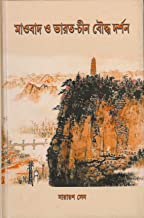
Narayan Sen (নারায়ণ সেন)
Kolkata: Creative Publication, 2013
Reviewed by Barnali Chanda (Ph.D. Candidate, Jadavpur University; 2016-17 HYI Comparative Literature Visiting Fellow)
Maoism in India has gained a pejorative meaning over the last few decades because of the ongoing conflict between Maoist groups and the Indian government. The book Maobad o Bharat-Cheen Bouddha Darshan (Maoism and the Buddhist Philosophy of India and China), by the well-known sinologist Narayan Sen, is not only one of the few cutting-edge scholarly works in Bengali but also an extremely important statement in the context of the present Indian governmental attitude towards China and Mao’s ideology. Narayan Sen clarifies this in the prologue section of the book. He says that the attempt to consider Maoism as synonymous with terrorism is an erroneous understanding. The book explains how Mao relentlessly struggled against both the indiscrete and extremist aspects of Marxism and Leninism. Sen examines Mao’s ideology by saying that, in order to occupy state-power, the proletariat class must practice non-violence until the bourgeoisie class oppresses their legitimate movement.
Out of the book’s ten chapters, the first eight meticulously describe Mao Zedong’s life and his initiation into the world of Marxism. In each chapter, Sen methodically examines Mao’s anti-imperialist struggle and tries to understand the application, conflict and domestication of Marxism and neo-democracy in China. He studies Mao’s unique views on the idea of revolution, including his approach and strategy, as Mao eventually formed his own party following a socialist construct. Sen categorically examines the backdrop and development of the Cultural Revolution and in that context also describes the Three Worlds Theory 三个世界的理论 and the Three Dimensional Diplomacy adopted by a new socialist China.
Sen devotes the ninth chapter of his book to discussing Buddhist philosophy and its influence on Mao Zedong. He mentions that no previous literature has studied the Buddhist influence on the formation of Mao’s thoughts and ideology. The relevance of this chapter is enormous in establishing the author’s point that Maoism or Mao’s ideology unequivocally refers to the idea of equality and service to the people, ideas which are also practiced in Buddhism. The chapter starts with Mao’s initial pre-1920 interest in understanding the basic teachings and applications of Buddhism in human life. An intriguing section of this chapter discusses the proverbs and sayings often used by Mao and the reception of Buddhist ideas in those proverbs. Sen mentions nineteen Chinese proverbs taken from various Buddhist sutras and Avadanas that are used by Mao to discuss imperialist and reactionary forces. Similarly, stories from popular operas and classical novels also helped Mao to review the pre-existing feudal system and to realize the urgency of adopting a new Chinese system of socialism. By discussing Mao’s thoughts on ideology, consciousness and matter, concrete and abstract Marxism, and historical tendencies of capitalism, Sen concludes the chapter by mentioning Mao’s conscious realization about the failure of the Cultural Revolution, which would in turn spur the antagonism that Mao would face from other members of the party.
Narayan Sen, by extensively using Chinese and Western sources, ends his book by mentioning the multiple possibilities of studying Mao Zedong’s life and his contribution in the formation of a new China.
